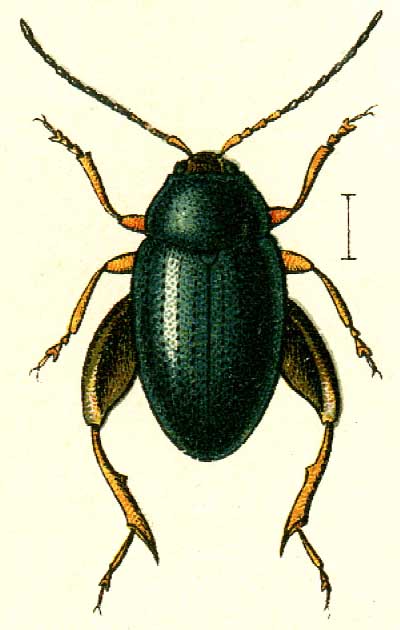
Psylliodes chrysocephalus
Superregnum: Eukaryota
Cladus: Unikonta
Cladus: Opisthokonta
Cladus: Holozoa
Regnum: Animalia
Subregnum: Eumetazoa
Cladus: Bilateria
Cladus: Nephrozoa
Cladus: Protostomia
Cladus: Ecdysozoa
Cladus: Panarthropoda
Phylum: Arthropoda
Subphylum: Hexapoda
Classis: Insecta
Cladus: Dicondylia
Subclassis: Pterygota
Cladus: Metapterygota
Infraclassis: Neoptera
Cladus: Eumetabola
Cladus: Endopterygota
Superordo: Coleopterida
Ordo: Coleoptera
Subordo: Polyphaga
Infraordo: Cucujiformia
Cladus: Phytophaga
Superfamilia: Chrysomeloidea
Familia: Chrysomelidae
Subfamilia: Galerucinae
Tribus: Alticini
Genus: Psylliodes
Species : Psylliodes chrysocephalus
Name
Psylliodes chrysocephalus (Linnaeus, 1758)
Original combination: Chrysomela chrysocephala
Synonyms
Chrysomela erythrocephala Linnaeus, 1758
Chrysomela anglica Fabricius, 1787
Altica anglicana Gmelin, 1790
Chrysomela nigricollis Marsham, 1802
Haltica cyanoptera Illiger, 1807
Haltica nucea Illiger, 1807
Macrocnema sordida Stephens, 1831
Psylliodes kunzei Foudras, 1860
Psylliodes rufilabris Allard, 1860
Psylliodes allardi Bach, 1866
Psylliodes catinensis Rottenberg, 1871
Psylliodes collaris Weise, 1888
Psylliodes peregrina Weise, 1888
Psylliodes sicardi Weise, 1894
Psylliodes longipennis Pic, 1903
Psylliodes castanea Abeille de Perrin, 1907
Psylliodes angulicollis Heikertinger, 1926
References
Linnaeus, C. 1758. Systema Naturae per regna tria naturæ, secundum classes, ordines, genera, species, cum characteribus, differentiis, synonymis, locis, Tomus I. Editio decima, reformata. Holmiæ: impensis direct. Laurentii Salvii. i–ii, 1–824 pp DOI: 10.5962/bhl.title.542: 172. Reference page.
Links
Psylliodes chrysocephalus Taxon details on Fauna Europaea
ZooBank: act:A6633D2D-109C-449D-B641-4BA979A47E40
European Chrysomelidae
Vernacular names
Deutsch: Großer Rapserdfloh
français: Altise du colza
Nederlands: Koolzaadaardvlo
norsk: Rapsjordloppe
русский: Рапсовая блошка
Psylliodes chrysocephala or Psylliodes chrysocephalus, commonly known as the cabbage-stem flea beetle, is a species of leaf beetle situated in the subfamily Galerucinae and the tribe Alticini (flea beetles).
Description
P. chrysocephala measures 3.0–4.0 mm in length. It is variably coloured, but most often a dark metallic blue.[1] Like all flea beetles it has large hind femora which it can use to jump. These are orange-red in colour with the hind femora darkened.[2]
It is differentiated from other members of the genus through a lack of anterior angles on its pronotum, the punctures on top of the head being as coarse as those on the elytra, and its first front tarsal segment being equal in length to its third.[1]
Psylliodes chrysocephala larva feeding in stem of Brassica napus
P. chrysocephala pupa
Adult beetle
Distribution
It is native to the Western Palaearctic, including Macaronesia, Cape Verde and North Africa and has been introduced into Canada.[2]
Lifecycle
Adult beetles mate in late August on the leaves of host plants, with eggs first laid 5–10 days after copulation. Oviposition takes place from the end of September through winter until mid-April and a single female may lay up to 1000 eggs, deposited in small clusters in the soil beneath the host plant at depths of 1–5 cm. Larvae hatch after about 60 days and feed within the stem and leaves of the host plant. Fully developed larvae emerge in early summer and pupate in the soil. Newly emerged adults appear from May each year. Adults may enter an aestivation period over Summer after the harvest of mature rape plants. After mating in late summer, some adults will overwinter.[3]
Behaviour and habitat
Brassica napus (rape seed)
P. crysocephala can be found in various habitats, depending on the availability of a host plant. It is particularly associated with wild and cultivated members of the plant family Brassicaceae.[2] It has been directly associated with Brassica napus, B. nigra (black mustard), B. oleracea (cabbages, cauliflowers), B. rapa (turnip rape), Nasturtium officinale (watercress), Raphanus sativus (radish), Sinapis alba (white mustard), S. arvensis (wild mustard), and Tropaeolum majus (common nasturtium).[4]
As an arable pest
It is a serious pest of rape in northern Europe. In central parts of Europe it has a cyclic appearance with peaks in populations at intervals of about seven years.[5] In the UK, it is the most important establishment pest of rape, leading to yield losses of up to 20%.[6]
References
Hubble, D. (2012). Keys to the adults of seed and leaf beetles of Britain and Ireland. Field Studies Council. p. 77.
"Psylliodes chrysocephala (Linnaeus, 1758)". UK Beetle Recording (Coleoptera.org_. Retrieved 16 February 2018.
Kig, V. (2003). "Data on the Biology of Cabbage Stem Flea Beetle, Psylliodes Crysocephalus (Linnaeus, 1758) (Coleoptera, Chrysomelidae, Alticinae)". Communications in Agricultural and Applied Biological Sciences. 68 (4): 231–237.
"Plantwise Technical Factsheet: cabbage stem flea beetle (Psylliodes chrysocephala)". Plantwise.
Alford, D. V.; Nilsson, C.; Ulber, B. (2008). "Insect Pests of Oilseed Rape Crops". In Alford, D. V. (ed.). Biocontrol of Oilseed Rape Pests. Blackwell. pp. 9–42.
Lane, A.; Cooper, D. A.; Dale, M. f. B.; Dewar, A. M; Froud-Williams, R. J.; Hocking, T. J.; Jones, D. G.; Rea, B. L. (1989). "'Production and protection of oilseed rape and other Brassica crops': A meeting held in Cambridge, Uk, 18-19 December 1989". Aspects of Applied Biology. 23: 269–276.
Retrieved from "http://en.wikipedia.org/"
All text is available under the terms of the GNU Free Documentation License

